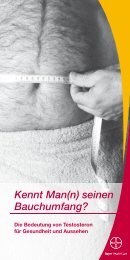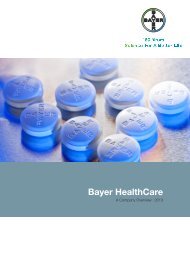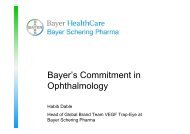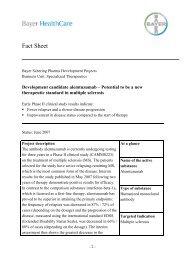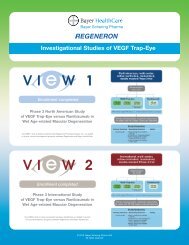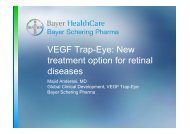Backgrounder Aspirin Cardio - Press - Bayer
Backgrounder Aspirin Cardio - Press - Bayer
Backgrounder Aspirin Cardio - Press - Bayer
Create successful ePaper yourself
Turn your PDF publications into a flip-book with our unique Google optimized e-Paper software.
Background Information<br />
Prevention of Heart Attack and Stroke<br />
Addressing Blood Clot Formation — <strong>Aspirin</strong><strong>Cardio</strong> ®<br />
<strong>Aspirin</strong><strong>Cardio</strong> ® ’s Unique Mode of Action<br />
• Low‐dose aspirin (acetylsalicyclic acid), the active ingredient of <strong>Aspirin</strong><strong>Cardio</strong> ® , belongs to a class<br />
of drugs called antiplatelet agents.<br />
• <strong>Aspirin</strong><strong>Cardio</strong> ® contains a low dose of aspirin (usually 100 mg, although slightly lower doses of<br />
75–100 mg are available in some countries).<br />
• Platelet aggregation is a key mechanism in thrombus (blood clot) formation and the<br />
development of cardiovascular (CV) events such as heart attack and stroke.<br />
• <strong>Aspirin</strong> interferes with the activation of platelets through a unique mechanism of action<br />
compared with other antiplatelet drugs by producing irreversible inhibition of an enzyme called<br />
cyclo‐oxygenase 1 (COX‐1).<br />
• By inhibiting COX‐1 in platelets, aspirin inhibits synthesis of a substance called thromboxane A2<br />
(TXA2), a potent activator of platelet aggregation.<br />
• The result is a sustained inhibition of platelet aggregation. By this mechanism, aspirin helps prevent<br />
the precipitating event, i.e., a blood clot responsible for both ischaemic heart attacks and strokes.<br />
<strong>Cardio</strong>vascular Benefits of <strong>Aspirin</strong><br />
• Although aspirin was originally recognized for its pain‐relieving and anti‐inflammatory<br />
properties, research in recent decades has shown that low‐dose aspirin can be effective in the<br />
prevention of certain CV events.<br />
• The benefits of aspirin are evident across the continuum of CV risk, from the prevention of a first<br />
CV event in patients with multiple risk factors to the prevention of recurrent events in patients<br />
with established CV or cerebrovascular (blood vessels of the brain) disease.<br />
• Low‐dose aspirin is currently approved in more than 50 countries for the prevention of a first CV<br />
event*. It is also approved worldwide for the prevention of recurrent CV events.<br />
Proven Benefit in <strong>Cardio</strong>vascular Disease<br />
• Low‐dose aspirin continues to be recognised as a life‐saving therapy and is the standard of care<br />
for reducing the risk of heart attacks and strokes in people with established cardiovascular<br />
disease (CVD) (secondary prevention).<br />
• The broader use of low‐dose aspirin in appropriate patients may help prevent many thousands<br />
of initial CV events worldwide and save substantial financial resources in both direct and indirect<br />
healthcare costs. 1<br />
* <strong>Bayer</strong> supports the use of low‐dose aspirin for primary prevention only in those countries where the<br />
indication has been approved. Only a physician can determine whether a patient is at sufficient risk<br />
of a cardiovascular event to warrant daily aspirin therapy.
• A recent meta‐analysis of the role of aspirin in the prevention of CVD, performed by the<br />
Antithrombotic Trialists’ Collaboration (ATTC), has reaffirmed the effectiveness of low‐dose<br />
aspirin in preventing recurrent CV events. 2<br />
• This evaluation, which included 16 secondary prevention trials involving approximately 17,000<br />
patients with previous CV events (e.g. heart attack, stroke or ‘mini‐stroke’ also called a transient<br />
ischaemic attack), showed that aspirin therapy is associated with a statistically significant<br />
reduction of recurrent CV events including:<br />
- 19% reduction in serious vascular events such as heart attacks, stroke or death from vascular<br />
causes<br />
- 20% reduction in major coronary events, such as heart attacks<br />
- 31% decrease in non‐fatal heart attacks<br />
- 13% reduction in heart‐related deaths<br />
- 22% decrease in stroke caused by thrombosis<br />
• <strong>Aspirin</strong> is also effective in reducing the risk of a first CV event in a range of subjects, as<br />
demonstrated in six landmark trials involving more than 95,000 individuals. 3,4,5,6,7,8<br />
• The ATTC meta‐analysis i included individual patient data from these six trials and reaffirmed<br />
that aspirin therapy is associated with a statistically significant reduction of CV events in people<br />
without CVD. Results demonstrated:<br />
- 12% reduction in serious vascular events<br />
- 18% reduction in major coronary events, such as heart attacks<br />
- 23% reduction in non‐fatal heart attacks<br />
- 14% reduction in stroke due to thrombosis<br />
- A greater that 2:1 benefit risk ratio on the primary prevention setting<br />
Potentially Substantial Reduction in CV Events<br />
• Numerous, multidisciplinary international consensus guidelines recommend low‐dose aspirin for<br />
the prevention of first and recurrent CV events in at‐risk individuals. 9,10,11,12,13,14,15 *<br />
• In spite of the widely known benefits of low‐dose aspirin therapy, it is thought to be widely<br />
underused in individuals who could benefit from it, even in people who are at high risk of<br />
developing CVD. 16,17,18,19<br />
- Results from the <strong>Aspirin</strong> Underutilisation and Compliance in CVD Treatment (ACT) study –<br />
based on the response of 7,363 physicians in 18 countries across Europe, Asia Pacific and<br />
South America to an online questionnaire – revealed that although low‐dose aspirin was<br />
recommended in more than 85% of patients with a previous heart attack, compliance<br />
remained sub‐optimal.<br />
- Compliance among patients in Europe who have previously suffered heart attacks was only<br />
29%, meaning that a large proportion of patients were not fully compliant in taking their life‐<br />
saving medicines regularly. 20<br />
* <strong>Bayer</strong> supports the use of low‐dose aspirin for primary prevention only in those countries where the<br />
indication has been approved. Only a physician can determine whether a patient is at sufficient risk<br />
of a cardiovascular event to warrant daily aspirin therapy.<br />
2
Well‐Established Safety Profile<br />
• <strong>Aspirin</strong> is one of the most extensively studied drugs in history, with a 110‐year history of clinical<br />
use.<br />
• While the most common side effects associated with aspirin use are GI related, the majority of<br />
them are minor and resolve without medical intervention. More serious effects, such as<br />
significant bleeding, are rare. (see Safety backgrounder for additional information)<br />
References<br />
1 Ford ES, Giles WH, Mokdad AH. The distribution of 10‐year risk for coronary heart disease among US adults: findings from<br />
the National Health and Nutrition Examination Survey III. J Am Coll <strong>Cardio</strong>l 2004;43:1791–6.<br />
2 Antithrombotic Trialists’ Collaboration. <strong>Aspirin</strong> in the primary and secondary prevention of vascular disease: collaborative<br />
meta‐analysis of indivdual participant data from randomised trials. Lancet 2009;373:1849–60.<br />
3 Peto R, Gray R, Collins R, et al. Randomised trial of prophylactic daily aspirin in British male doctors. Br Med J (Clin Res Ed)<br />
1988;296:313–6.<br />
4 Steering Committee of the Physicians' Health Study Research Group. Final report on the aspirin component of the<br />
ongoing Physicians' Health Study. N Engl J Med 1989;321:129–35.<br />
5 Thrombosis prevention trial: randomised trial of low‐intensity oral anticoagulation with warfarin and low‐dose aspirin in<br />
the primary prevention of ischaemic heart disease in men at increased risk. The Medical Research Council's General<br />
Practice Research Framework. Lancet 1998;351:233–41.<br />
6 Hansson L, Zanchetti A, Carruthers SG, et al. Effects of intensive blood‐pressure lowering and low‐dose aspirin in patients<br />
with hypertension: principal results of the Hypertension Optimal Treatment (HOT) randomised trial. HOT Study Group.<br />
Lancet 1998;351:1755–62.<br />
7 de Gaetano G; Collaborative Group of the Primary Prevention Project. Low‐dose aspirin and vitamin E in people at<br />
cardiovascular risk: a randomised trial in general practice. Lancet 2001;357:89–95.<br />
8 Ridker PM, Cook NR, Lee IM, et al. A randomized trial of low‐dose aspirin in the primary prevention of cardiovascular<br />
disease in women. N Engl J Med 2005;352:1293–304.<br />
9 American College of Chest Physicians. Antithrombotic and thrombolytic therapy: 8th edition. Primary and secondary<br />
prevention of coronary artery disease. Chest 2008; 133:776S–814S.<br />
10 Mosca L, Banka CL, Benjamin EJ et al for expert panel/writing group. AHA Guideline. Evidence‐based guidelines for<br />
cardiovascular disease prevention in women: 2007 update. Circulation. 2007;115:1481‐501.<br />
11 WHO: Prevention of <strong>Cardio</strong>vascular Disease. Pocket Guidelines for Assessment and Management of <strong>Cardio</strong>vascular Risk<br />
2007.<br />
12 Fourth Joint Task force of the European Society of <strong>Cardio</strong>logy and other societies on cardiovascular disease prevention in<br />
clinical practice. European guidelines on cardiovascular disease prevention in clinical practice: European guidelines on<br />
cardiovascular disease prevention in clinical practice: Executive summary. Eur Heart J 2007; 28:2375–414.<br />
13 American Diabetes Association. Standards of medical Care in Diabetes–2009. Position Statement. Diabetes Care<br />
2009;32:S13–61.<br />
14 The Task Force on Diabetes and <strong>Cardio</strong>vascular Diseases of the European Society of <strong>Cardio</strong>logy (ESC) and of the European<br />
Association for the Study of Diabetes (EASD) ESC/EASD Task Force. Guidelines on diabetes, pre‐diabetes, and<br />
cardiovascular diseases: executive summary. Eur Heart J 2007;28:88–136.<br />
15 The Seventh Report of the Joint National Committee on Prevention, Detection, Evaluation, and Treatment of High Blood<br />
<strong>Press</strong>ure. Hypertension. 2003;42:1206.<br />
16 <strong>Bayer</strong> HealthCare LLC, Consumer Care Division, 2006 Global <strong>Cardio</strong> Market Study<br />
17 Stafford RS, Monti V, Ma J. Underutilization of <strong>Aspirin</strong> Persists in US Ambulatory Care for the Secondary and Primary<br />
Prevention of <strong>Cardio</strong>vascular Disease. PLoS Med 2005;2: e353.<br />
18 Stafford R, Ma J. Continued suboptimal use of <strong>Aspirin</strong> in patients at high and moderate risk for CHD events. Presented at<br />
the Society of General Internal Medicine Annual Meeting, Chicago, Ill., May 12‐15, 2004 (Abstract).<br />
19 <strong>Bayer</strong> <strong>Aspirin</strong>/American College of Preventive Medicine market research survey. Conducted by Harris Interactive, January<br />
2005.<br />
20 Zaninelli A, et al. Adherence to low‐dose aspirin in secondary prevention: a comparison of European, Latin‐American<br />
and Asia‐Pacific countries. Abstract presented at the East Meets West <strong>Cardio</strong>logy Congress 2009.<br />
3



